Submitted by EBCI Natural Resources
CHEROKEE, N.C. – Water quality on the Qualla Boundary is maintained by adherence to federally approved Tribal water quality standards written in the Cherokee Code. These water quality standards comply with the Clean Water Act. Water quality criteria are listed in the Eastern Band of Cherokee Indians’ Water Quality Standards: Administrative Rules, Section 4: General Water Quality Criteria, and Section 5: Water Quality Criteria for Specific Uses. Water quality regulations are also found in Chapter 113E – WATER QUALITY CODE FOR TRIBAL WATERS.
The NRD monitors the health of the Oconaluftee River by evaluating the following parameters:
Dissolved oxygen – Oxygen is critical for aquatic life. The value for dissolved oxygen should be above 5 mg/L.
pH – pH measures the acidity or alkalinity of water with expected values ranging from 6-9. Anything below 6 is too acidic and anything above 9 is too basic which can be troublesome for aquatic organisms.
Nutrients – EBCI Natural Resources monitors for total phosphorus and total nitrogen in the waters but do not have regulatory parameters for these two nutrients. Nutrient pollution can come from agricultural runoff and lawn fertilizer as well as from wastewater treatment plants. High total phosphorus amounts can cause toxic algal blooms, which can kill off any organisms living in the stream or river and can make humans and their pets sick. For total nitrogen, higher amounts can be troublesome for aquatic organisms.
Turbidity – This parameter measures the amount of suspended particulate matter in our water and should be less than 10 NTU. Turbid waters caused by sediment from stormwater runoff can harm fish gills and smother reproductive habitat. For instance, after a rainstorm, the water could be brown with suspended sediment in the river.
Escherichia coli (E. coli): These bacteria are naturally occurring in the digestive tracts of people and animals. E coli can be found in moving waters such as rivers and streams from waste pollution. Values should be less than 126 MPN/100mL. Anything higher increases the possibility of making a human being sick.
Temperature – For coldwater streams that contain trout, the temperature should be less than 29 degrees Celsius. Anything higher can create conditions where trout are stressed, less healthy and unable to live year-round.
The sample station for the “Source Water” data collection is upstream of the drinking water plant intake. The sample station for the lower Oconaluftee River is a USGS Gauging Station supported by the EBCI located downstream of the Cherokee Wastewater Treatment Plant. This station takes continuous readings which are accessible via the USGS webpage (https://waterdata.usgs.gov/nwis/uv?site_no=03512000&legacy=1 ).The data from this reporting period for both the “Source Water” and the USGS Gauging Station indicate overall healthy river conditions.
See the following graphs for more information on specific parameters. The red lines represent thresholds for a healthy aquatic system.
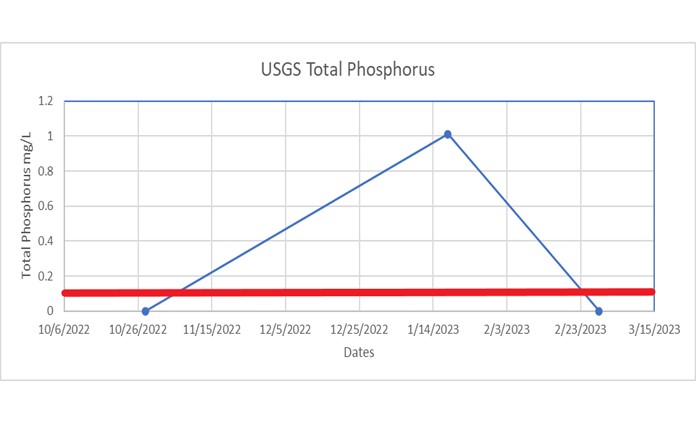
Total phosphorus can come from a number of different sources including effluent from the CWWTP upstream or from a rain event. Historically, phosphorus spikes are rare, so the levels observed on Jan. 14, 2023 are seen as an anomaly and future monitoring will continue to evaluate this potential pollutant.
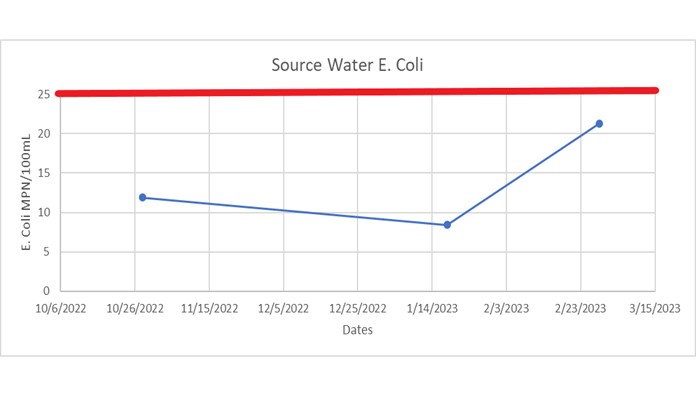
The E. Coli levels at the Source Water site are all well below the threshold of 126 MPN/100mL as you can see on the graph. The sample points don’t go above 25 MPN/100mL. Anything above the threshold is a hazard to both animals and people.
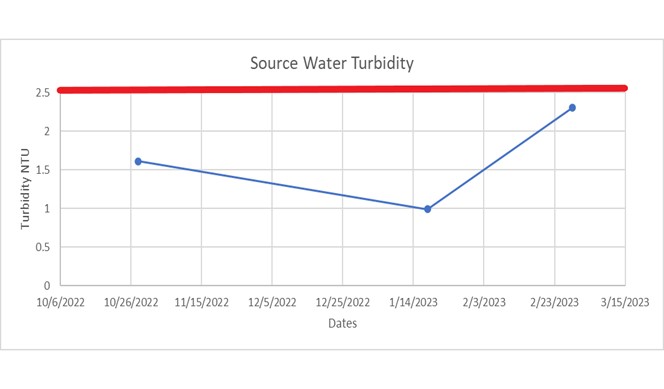
The “Source Water” turbidity is well below the threshold of 10 NTU, which is excellent, and means there is very little suspended in the water column. For cold water trout streams, turbidity needs to be between 0 to 10 NTU.
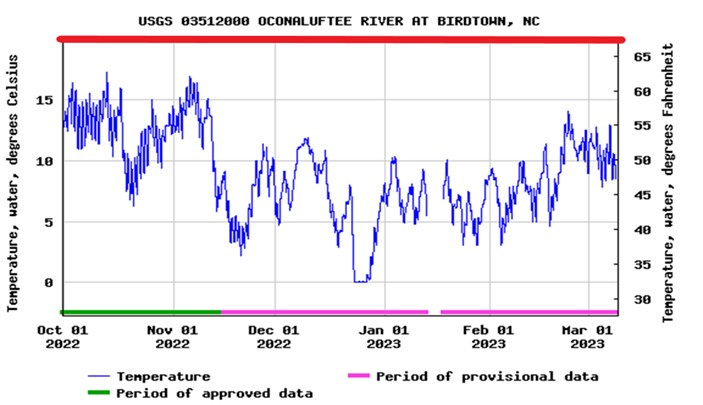
The temperature is well below the threshold of 29 degrees Celsius, which is good for the organisms living in the river, such as trout, which need cold temperatures to thrive.
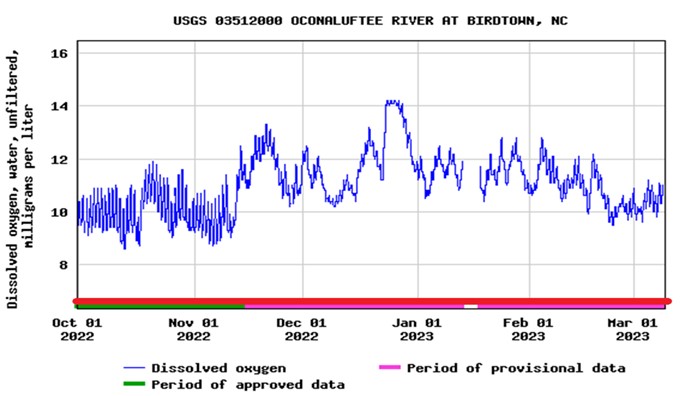
The dissolved oxygen is well above the minimum threshold of 5mg/L, meaning there is enough oxygen in the water to support healthy aquatic organisms, such as trout.
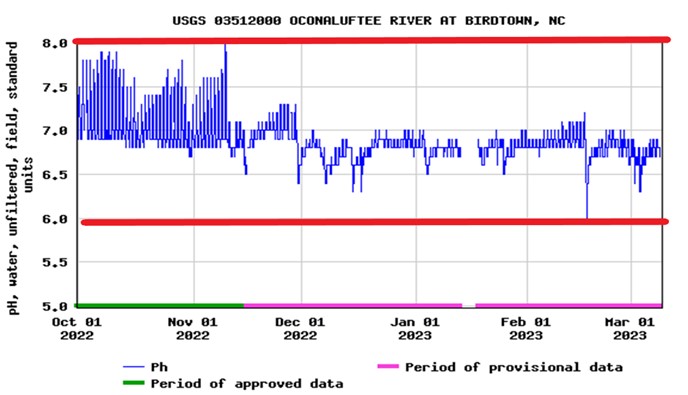
The pH is within the minimum and maximum threshold of 6-9, meaning that it is an acceptable level for the life within the stream. In Section 4.1.3 of the Tribal WQS Rules the pH needs to be between 6 – 9, anything lower than a 6 is too acidic and will kill most organisms in the water, and anything above 9 is too basic and is also toxic for the organisms.
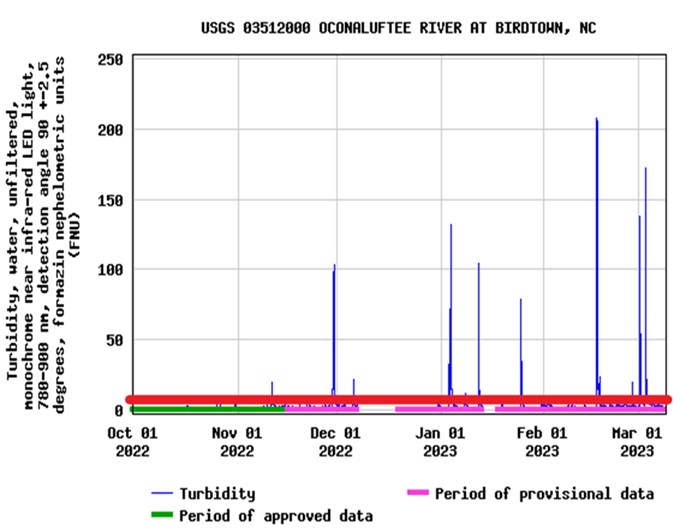
Turbidity levels at this site are generally below the threshold expected. The spikes observed are associated with rain events that produce stormwater runoff and naturally stir up instream sediment. Implementing best practices for stormwater runoff continues to be a priority for the EBCI.
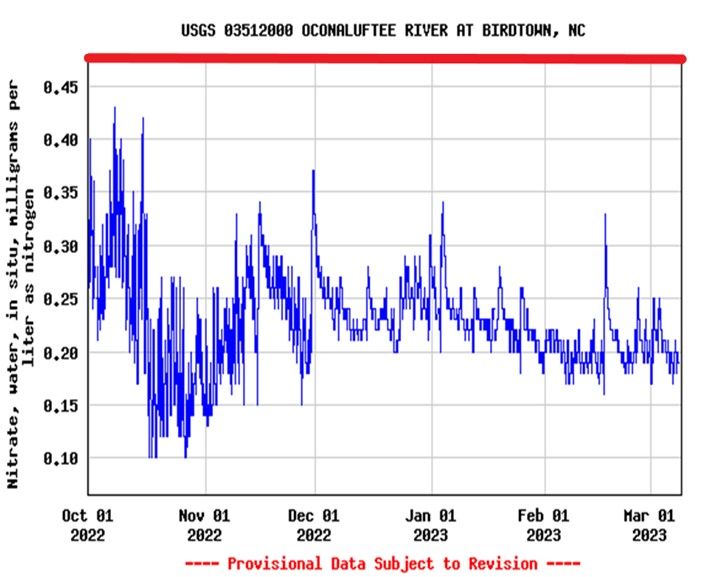
The nitrate is well below the threshold of 0.46. Anything over that amount can have negative consequences for water quality. Those adverse effects include algae blooms, accelerated plant growth, and low dissolved oxygen from the decomposition of additional vegetation. An excess of nitrogen can lead to low levels of dissolved oxygen and negatively impact various lifeforms living in the water.





